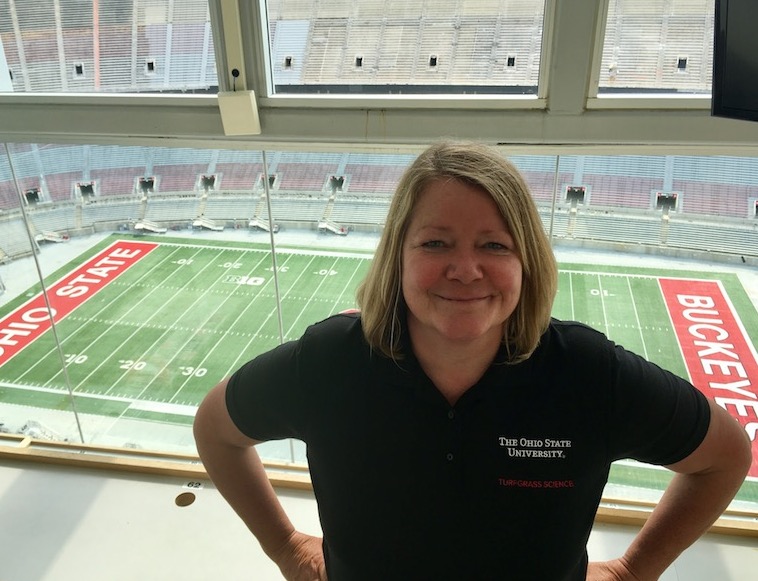Q: Can you suggest some tips for artificial turf maintenance, grooming frequency, basic repairs? Thank you.
– Stephen F.
A: First, check the manufacturer’s recommendations to make sure you will not void the warranty. Each manufacturer will have guidelines to make sure that the integrity of the playing surface is preserved. Make a copy of the manufacturer’s guidelines, and plan your maintenance program around it.
Be proactive in your approach to taking care of the field. Use signage to communicate your expectations to field users. For example, prohibit smoking, carrying food and drinks onto the field, and chewing gum. Prohibit fireworks and open flames. Don’t store equipment on the field or allow athletes to wear long metal-spiked shoes. Make sure equipment is within certain load limits, that turf tires are used, and the equipment operator takes slow, wide turns to avoid damaging the surface. Field protection systems such as mats could be used in high-wear areas. Rotate traffic during practice sessions if possible. Setting some boundaries is a good place to start.
Regarding maintenance, let’s look at grooming/brushing first as this is the most common maintenance practice. Many synthetic field installers will provide a groomer as part of the field construction contract. A typical guideline is to groom the field once every 40 hours of field use. Grooming will stand the fibers up and maintain uniform infill distribution. Checking infill depth with an infill depth gauge when grooming the field is good practice. The infill material does not break down, but gets redistributed during play. Grooming keeps infill distributed evenly. Any low area needs to be topdressed with the same material that was used at installation (never introduce another infill type). Grooming is also used to stripe the field and make it more aesthetically pleasing. Fields are generally groomed in the same direction as the seams, not perpendicular to them, to prevent seam snagging and tearing. Just be careful not to snag the sidelines.
Safety of the athlete is paramount, so regularly check for metal and other deleterious debris. Grooming can help to remove leaves and debris such as athletic tape. If debris is not picked up during the grooming process, a lawn sweeper should be used. A magnet will pick up metal debris. Removing bodily fluids such as vomit is done by flushing with water and using a mild detergent that’s turf specific. Removing gum is harder and requires the use of an aerosol freezing agent. The process of removing snow is the same as natural grass, with a few exceptions – notably, not using any darkening agents or getting too close to the surface with the snowplow, potentially rippling the turf, tearing seams, and causing ruts under the carpet (refer to the SFMA publication “Snow Removal on Natural and Synthetic Athletic Surfaces”).
Synthetic turf surfaces can get very hot in the summer, especially on cloudless, hot days. The synthetic fibers are not capable of transpirational cooling like natural grass leaves, so will hold heat that can result in excessive temperatures. One misconception about synthetic turf maintenance is that irrigation can be used to cool the surface. The cooling effect from irrigation only lasts about 20 minutes, so it isn’t really an effective cooling method. A better approach is to monitor the heat index and limit use of the fields during the hottest parts of the day, especially for younger athletes and kids that are physically closer to the playing surface. It is still helpful to have a water source at the field for cleaning and sanitation purposes.
Chemical applications on the field should follow the warranty guidelines. It was originally thought that outdoor synthetic fields needed to be sanitized with a disinfectant material to prevent the buildup of organisms like the bacterium Staphylococcus aureus. Research at Penn State showed that ultraviolet radiation in sunlight and high surface temperatures were the most effective natural disinfectant against S. aureus on outdoor fields. Indoor fields, equipment and changing room/gyms etc. are more likely to be treated with antimicrobial products. Fabric softeners and anti-static products are sometimes applied to new fields if static electricity and infill splash is an issue. Weeds are more likely to occur on fields that have a natural organic infill material. If weeds become a problem, non-selective herbicides can be used to control them. As always, check to make sure no prohibited chemical applications are made, and never add bulky organic materials/granular products to the field that can clog-up fibers and inhibit drainage.
Regarding minor repairs, such as a ripped seam, or replacement of a small spot, the manufacturer will train you in how to make those repairs. Typically, the infill material is sucked out with a handheld vacuum, glue is used to make the repair, and the infill in reapplied.
Pamela Sherratt
Sports turf extension specialist
The Ohio State University
Questions?
Send them to Pamela Sherratt at 202D Kottman Hall, 2001 Coffey Road, Columbus, OH 43210 or sherratt.1@osu.edu
Or send your question to Dr. Grady Miller, North Carolina State University, Box 7620, Raleigh, NC 27695-7620, or grady_miller@ncsu.edu


